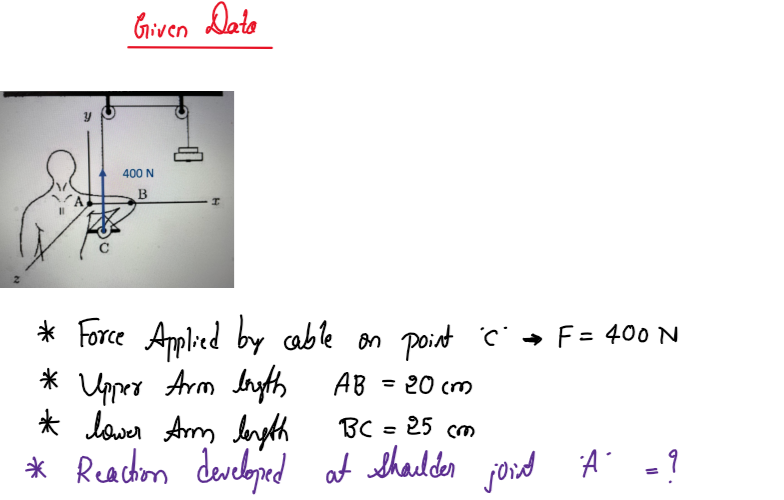The weight of the limb is W=15 lbs.The contact of foot with the ground can be modeled as a pin/hinge here. Determine the reaction force of the ground and the reaction at the knee joint and its direction/angle θ. Note: use the thee force member condition to find the angle of FK.Q4.As it’s been shown in the below figure,a person is using an exercise machine. Points A and B correspond to the shoulder and elbow joints, respectively. Relative to the person, the upper arm (AB) is extended toward the left (x-direction) and the lower arm (BC) is extended forward (z-direction). At this instant, the person is holding a handle that is connected by a cable to a suspending weight. The weight applies an upward (in the y-direction) force with magnitude F on the arm at point C. The lengths of the upper arm and lower arm are AB̅̅̅̅= 20cm and BC̅̅̅̅= 25cm, respectively, and the magnitude of the applied force is F = 400 N.Determine the components of reaction developed at the shoulder joint A When the system is in equilibrium. Consider the shoulder joint as fixed in this condition and neglect the weights of the upper and lower arm
The weight of the limb is W=15 lbs.The contact of foot with the ground can be modeled as a pin/hinge here. Determine the reaction force of the ground and the reaction at the knee joint and its direction/angle θ. Note: use the thee force member condition to find the angle of FK.Q4.As it’s been shown in the below figure,a person is using an exercise machine. Points A and B correspond to the shoulder and elbow joints, respectively. Relative to the person, the upper arm (AB) is extended toward the left (x-direction) and the lower arm (BC) is extended forward (z-direction). At this instant, the person is holding a handle that is connected by a cable to a suspending weight. The weight applies an upward (in the y-direction) force with magnitude F on the arm at point C. The lengths of the upper arm and lower arm are AB̅̅̅̅= 20cm and BC̅̅̅̅= 25cm, respectively, and the magnitude of the applied force is F = 400 N.Determine the components of reaction developed at the shoulder joint A When the system is in equilibrium. Consider the shoulder joint as fixed in this condition and neglect the weights of the upper and lower arms.


Trending now
This is a popular solution!
Step by step
Solved in 3 steps with 4 images









